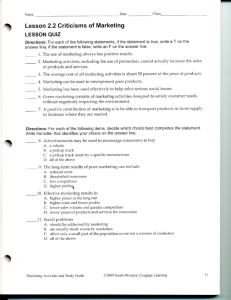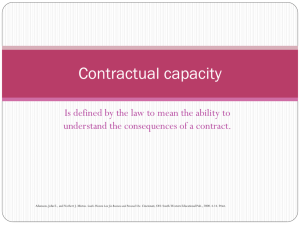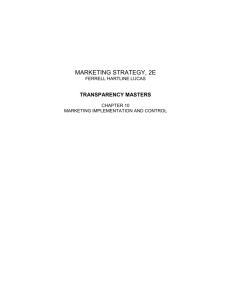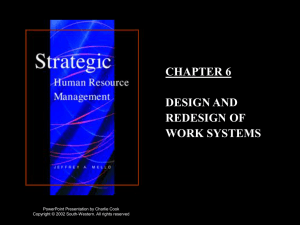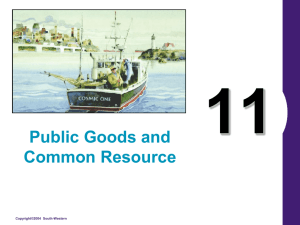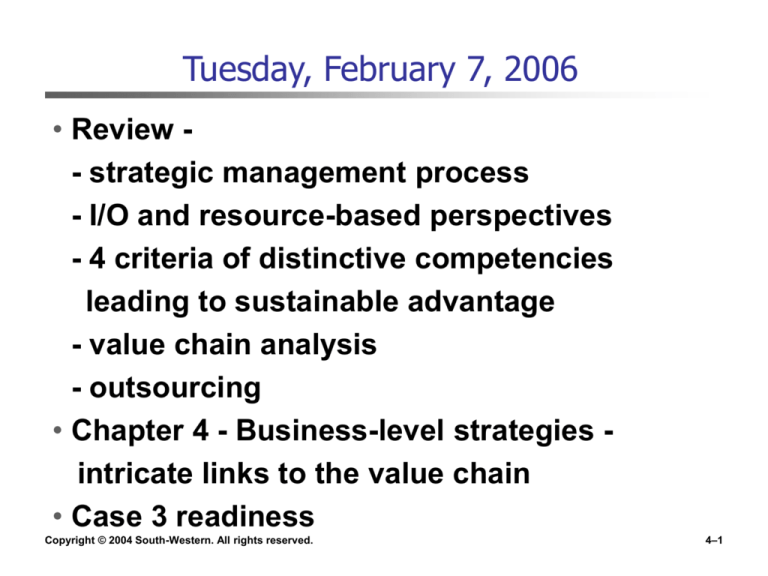
Tuesday, February 7, 2006
• Review - strategic management process
- I/O and resource-based perspectives
- 4 criteria of distinctive competencies
leading to sustainable advantage
- value chain analysis
- outsourcing
• Chapter 4 - Business-level strategies intricate links to the value chain
• Case 3 readiness
Copyright © 2004 South-Western. All rights reserved.
4–1
Chapter 4: Business-Level Strategy
• Strategy
• 5 “generic business-level strategies”
-characteristics
-how to develop
-advantages and disadvantages
• “Stuck-in-the-middle”
Copyright © 2004 South-Western. All rights reserved.
4–2
The Strategic
Management
Process
Figure 1.1
Copyright © 2004 South-Western. All rights reserved.
Copyright © 2004 South-Western. All rights reserved.
4–3
Generalized Corporate Structure
PepsiCo
Pepsi-Cola
Frito-Lay
Copyright © 2004 South-Western. All rights reserved.
Tropicana
4–4
Successful Strategies
match the firm’s core competencies with
customer needs, paying attention to . . .
• careful selection of the target market
• insightful knowledge of and effective
relationships with the target market
• continuous improvement of strategy
execution
• providing unexpected value
Copyright © 2004 South-Western. All rights reserved.
4–5
“Generic Business-Level Strategy”
= how a firm intends to compete at the
business-unit (division) level, in
VERY GENERAL terms . . . .
2 VERY BASIC ways to compete to achieve
above-average profits:
1. Price premium to create higher revenues
2. Efficiencies to create lower costs
Copyright © 2004 South-Western. All rights reserved.
4–6
Also consider breadth of target markets . . .
• Broad scope =
the firm competes in many market
(customer) segments
• Narrow scope =
the firm selects one or two market segments
Copyright © 2004 South-Western. All rights reserved.
4–7
Five BusinessLevel Strategies
SOURCE: Adapted with the
permission of The Free Press, an
imprint of Simon & Schuster Adult
Publishing Group, from Competitive
Advantage: Creating and Sustaining
Superior Performance, by Michael E.
Porter, 12. Copyright © 1985, 1998
by Michael E. Porter.
Figure 4.1
Copyright © 2004 South-Western. All rights reserved.
4–8
Cost Leadership Strategy
• An integrated set of actions taken to
produce goods or services with features
that are acceptable to customers at the
lowest cost, relative to that of competitors
Relatively standardized products
Features acceptable to many customers
Generally uses a mass market approach with
little segmentation
Lowest competitive price
Copyright © 2004 South-Western. All rights reserved.
4–9
Cost Leadership Strategy Steps to develop:
examine value chain for potential cost savings
pay extra attention to “cost drivers” (areas of
significant costs in the organization)
no stone is left unturned! no sacred cows! (but
need to maintain product acceptability)
look both inside and outside the firm for potential
areas of cost savings
reconfigure the value chain to accomplish cost
savings
Copyright © 2004 South-Western. All rights reserved.
4–10
Ideas for Cost Reduction
Primary Value
Chain Activities
Support Activities in the
Value Chain
•
•
•
•
•
•
•
•
Copyright © 2004 South-Western. All rights reserved.
4–11
How to Obtain a Cost Advantage
Determine and
control
Reconfigure, if
needed
Cost Drivers Value Chain
Alter production process
New raw material
Change in automation
Forward integration
New distribution channel
Backward integration
Change location relative
to suppliers or buyers
JIT - suppliers bear costs
New advertising media
Outsource or omit some
value chain activities
Copyright © 2004 South-Western. All rights reserved.
4–12
Common Characteristics of Cost Leaders
(see value chain example, Fig. 4.2, pg. 116)
• cost conscious organizational culture
• intense scrutiny of expenses
• budget centralization
• focus on efficiency
• scale economies
• process engineering skill
• technologically advanced
• lean management; limited “perks and frills”
• spartan facilities
Copyright © 2004 South-Western. All rights reserved.
4–13
Main Advantages of Cost Leadership
• Scale economies
• Efficiency
• Market power
• Ability to attract price sensitive customers
• Ability to withstand price wars
Copyright © 2004 South-Western. All rights reserved.
4–14
Cost Leadership Strategy
• Competitive Risks
sunk costs
obsolescence
image
internally focused attention
efficiency might dominate effectiveness
Copyright © 2004 South-Western. All rights reserved.
4–15
Differentiation Strategy
• An integrated set of actions taken to
produce goods or services (at an
acceptable cost) that customers perceive
as being different in ways that are
important to customers
Products are nonstandardized
Customers value differentiated features more
than they value low cost
Generally involves more extensive market
segmentation
Copyright © 2004 South-Western. All rights reserved.
4–16
Differentiation Strategy Steps to develop:
identify the target market, the “real buyers”, and
others influential in the buying process
determine important buyer purchasing criteria
throughout the value chain; understand the
buyer’s purchase process (consumer behavior!)
develop relevant sources of uniqueness -- as
long it is as reasonable in terms of cost
lower costs elsewhere in value chain if possible
Copyright © 2004 South-Western. All rights reserved.
4–17
“Relevant sources of valued uniqueness” =
Primary Value
Chain Activities
Support Activities of the
Value Chain
•
•
•
•
•
•
•
•
Copyright © 2004 South-Western. All rights reserved.
4–18
How to Obtain a Differentiation Advantage
Control if needed
Cost Drivers
Reconfigure to
maximize
Value Chain
Lower buyers’ (maybe non-monetary) costs
Raise performance of product or service
Create sustainability through:
Customer perceptions of uniqueness
Customer reluctance to switch to nonunique product or service
Copyright © 2004 South-Western. All rights reserved.
4–19
Common Characteristics of Differentiators
(see value chain example, Fig. 4.3, pg. 120)
• strong emphasis on the marketing functions
- market segmentation, marketing research,
new product development, promotion . . . .
• elaborated product; additional/new features
• image/reputation emphasis
• tailoring to customer needs/preferences
• higher levels of service and/or quality
• higher compensation for desired workforce
• innovativeness
• “organizational slack”
Copyright © 2004 South-Western. All rights reserved.
4–20
Primary Advantages of Differentiation
• Ability to charge a price premium
• Customer loyalty
• Insulation from pure price competition
• Image
Copyright © 2004 South-Western. All rights reserved.
4–21
Competitive Risks of Differentiation
• price differential between the differentiator and the
cost leader becomes too large
• differentiation ceases to provide value for which
customers are willing to pay (“benefit erosion”)
• “over-differentiation”
• counterfeit goods or information asymmetries result
in imitation of the differentiated features
Copyright © 2004 South-Western. All rights reserved.
4–22
Focus Strategies
• An integrated set of actions taken to
produce goods or services that serve the
needs of a particular competitive segment
Focus is typically on one or two specific
(relatively narrow) market segments
Can use either cost leadership or differentiated
approach, but the latter is more common
Copyright © 2004 South-Western. All rights reserved.
4–23
Factors That Drive Focused Strategies
• Large players may overlook small niches.
• A smaller/newer player may lack the resources
needed to compete in the broader market
• An organization is able to serve a narrow market
segment more effectively than can its larger
industry-wide competitors
• Focusing allows the firm to effectively direct its
resources to build competitive advantage
• Expanding to additional target markets is possible
when a strong niche position is established.
Copyright © 2004 South-Western. All rights reserved.
4–24
Competitive Risks of Focus Strategies
• May be “outfocused” by its competitors
• A large competitor may come in
• Customer preferences in niche market may change
• Are available niches the unattractive “leftover”
market segments?
Copyright © 2004 South-Western. All rights reserved.
4–25
Integrated Cost Leadership/
Differentiation Strategy
• It sounds ideal to be simultaneously the
cost leader and a strong differentiator.
• Increasingly, firms are trying to blend the
two major business-level strategies.
• But formulation is easier than
implementation!
Copyright © 2004 South-Western. All rights reserved.
4–26
Risks of the Integrated Cost Leadership/
Differentiation Strategy
• Often involves compromises
Becoming neither the lowest cost nor the most
differentiated firm
• Becoming “stuck in the middle”
Lacking the strong commitment and expertise
that accompanies firms following either a cost
leadership or a differentiated strategy
Copyright © 2004 South-Western. All rights reserved.
4–27
Functional Skill Comparisons
•
•
•
•
•
•
•
•
Cost Leadership
efficiency
standardization
mass production
process improvement
reduced service
tight org’l control
stability
cost accounting
Copyright © 2004 South-Western. All rights reserved.
•
•
•
•
•
•
•
•
Differentiation
effectiveness
customization
shorter production runs
product development
enhanced service
org’l slack is needed
flexibility
marketing
4–28
Characteristics to Facilitate Successful
Implementation of Integrated Cost
Leadership/Differentiation Strategy
• large (global) market share
• economies of scale
• learning curve advantages
(industry pioneers)
• advanced/efficient production capabilities
• marketing prowess
Copyright © 2004 South-Western. All rights reserved.
4–29
Overall Advice for Business-Level Strategy
• Understand your resources, capabilities,
and target market(s)
• Be true to your distinctive competence -base your strategies on your strengths!
• Be as good as possible at activities not
primary to your strategy -- without eroding
your competitive advantage.
• Remember -- strategies must be
implemented through value chain activities
• Realize that you cannot be all things to all
people -- or you will be valuable to none!
Copyright © 2004 South-Western. All rights reserved.
4–30


